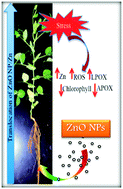Physiological effects of nanoparticulate ZnO in green peas (Pisum sativum L.) cultivated in soil
Abstract
The toxicological effects of zinc oxide nanoparticles (ZnO NPs) in plants are still largely unknown. In the present study, green pea (Pisum sativum L.) plants were treated with 0, 125, 250, and 500 mg kg−1 of either ZnO NPs or bulk ZnO in organic matter enriched soil. Corresponding toxicological effects were measured on the basis of plant growth, chlorophyll production, Zn bioaccumulation, H2O2 generation, stress enzyme activity, and lipid peroxidation using different cellular, molecular, and biochemical approaches. Compared to control, all ZnO NP concentrations significantly increased (p ≤ 0.05) root elongation but no effects were observed in the stem. Whereas all bulk ZnO treatments significantly increased both root and stem length. After 25 days, chlorophyll in leaves decreased, compared to control, by ∼61%, 67%, and 77% in plants treated with 125, 250, and 500 mg kg−1 ZnO NPs, respectively. Similar results were found in bulk ZnO treated plants. At all ZnO NP concentrations CAT was significantly reduced in leaves (p ≤ 0.05), while APOX was reduced in both roots and leaves. In the case of bulk ZnO, APOX activity was down-regulated in the root and leaf and CAT was unaffected. At 500 mg kg−1 treatment, the H2O2 in leaves increased by 61% with a twofold lipid peroxidation, which would be a predictive biomarker of nanotoxicity. This study could be pioneering in evaluating the phytotoxicity of ZnO NPs to green peas and can serve as a good indicator for measuring the effects on ZnO NPs in plants grown in organic matter enriched soil.


 Please wait while we load your content...
Please wait while we load your content...